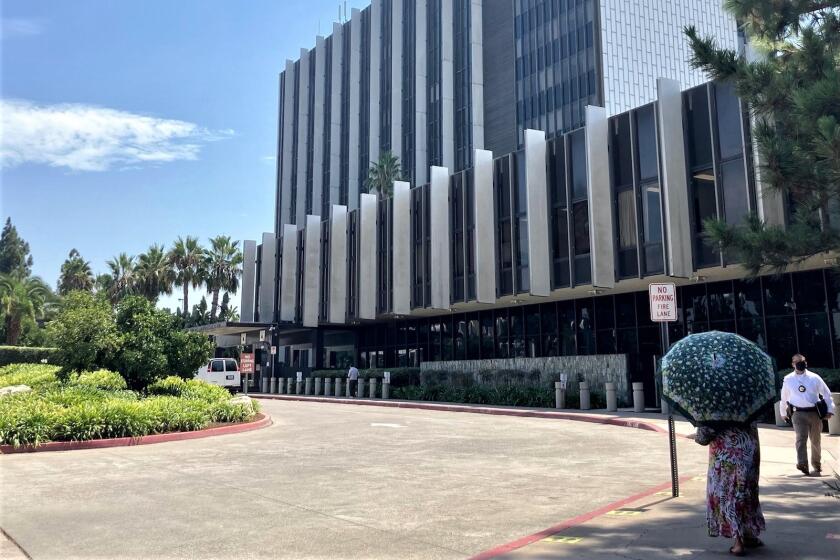Repurposing the obsolete
- Share via
Michael Graham was on the wrong kind of a roll.
Since 1993, he’d applied for various public art opportunities in and around Laguna Beach — 10, to be exact. Invariably, he’d make it to the finals, right to the cusp of victory, before being turned away.
Until last year.
The Laguna Hills resident was tapped by Laguna Beach’s Arts Commission to install a temporary exhibit at the site of a red British telephone booth on Forest Avenue. Graham was one of several artists whose proposals aimed at revamping the K6 phone kiosk, modeled after Sir Giles Gilbert Scott’s 1935 creation.
“We’ve had that English-style telephone booth for years, but no one uses pay phones anymore,” said Commissioner Mary Ferguson, also the group’s treasurer. “It’s a charming fixture but ... completely obsolete.”
She praised Cultural Arts Manager Sian Poeschl’s idea, which received a unanimous City Council vote last January, stipulating that the selected artist could construct work using the box’s interior or exterior, so long as its door remained shut. Although the city will oversee the maintenance of Graham’s sculpture, which earned him $2,000, it will be returned to its owner after two years.
Titled “I Want to Make a Phone Call,” the piece comprises an aluminum sculpture of a man who looks as if he is struggling to open the booth. A public dedication is slated for 5 p.m. March 20, followed by a reception at 381 Forest Ave.
“It’s interesting, whimsical and makes people stop and say, ‘What is this?’” Ferguson remarked. “Michael really used that area in front of the booth to call attention to the installation. He did it in a humorous way and we’re very happy. It was a unanimous decision, as I recall.”
After looking at the kiosk awhile, Graham, 61, recalled letting his imagination take the lead. Having decided right away that he didn’t want to decorate the box with flowers, he was inspired by the fact that the door was locked.
So he began playing with the idea of a man who, despite the advent of technology, has given up his cell phone. It aggravates him, Graham said, that personal communication is losing its value with people’s eyes glued to mobile screens and still others dependent on Bluetooths.
Upon spotting the red booth, he is overcome by nostalgia and decides to place a call to his friend. But not completely aware of his surroundings, he doesn’t notice that neither is there any equipment inside, nor is it possible to enter the kiosk. He is a determined sort, according to Graham, and ends up frustrated, desperately trying to pry open the door.
“I was fairly frivolous and thought, ‘Let’s just play with this,’ before throwing out the idea,” the sculptor said. “I thought, ‘This would be fun. They’re not going to accept it, but that’s all right.’”
When his computer dinged, indicating the arrival of an email in which he was informed that his proposal had been accepted, Graham recounted blurting out, “You’re kidding me.”
A Laguna Beach resident between 1989 and 2001, Graham moved away in search of a large but affordable working space. It is in this 2,500-square-foot studio in Laguna Hills that the artist, who made a sudden switch from wood to metal sculpture in 1985, worked on the technically precise project.
Starting out, Graham used cardboard to build a small-scale model of the booth and attached sculpture. He also recreated the box’s front door, down to its exact measurements, to ensure that there was no mistake in the attachment points. Although the final product looks simple, he said, it was a challenge to recreate the design using aluminum — the materials behave vastly differently.
The entire process took about six months, but that’s not to say he worked continuously for the entire duration. Instead, he would work on it for a week and then step away briefly in the hope of gaining a fresh perspective.
Since “I Want to Make a Phone Call” is the city’s responsibility, it is “clean shaven,” Graham said. The sculpture is stable, can’t be moved and has no sharp edges.
It’s also led to a surprising — and gratifying — amount of public attention, he remarked. About half of those who have taken note of his construction stopped to compliment him. Some would ask if they could take a photograph in it, while others asked, “What’s going on here?”, “What’s the reason for this?” or “Are you still using the phone?”
Although it’s rewarding to gain positive feedback, Graham, who credits his early exposure to theater for freeing him from the shackles of peer pressure, subscribes to the adage that artists can’t afford to get bogged down by viewers’ responses.
“I think any of us that are creative have a certain part of what we create in parenthesis,” he said. “And we don’t know if the parenthesis will go away and people — even if it’s a small group — will get it.”
All the latest on Orange County from Orange County.
Get our free TimesOC newsletter.
You may occasionally receive promotional content from the Daily Pilot.



